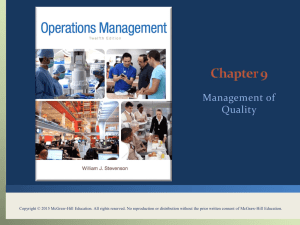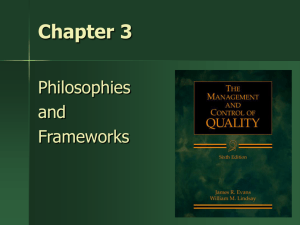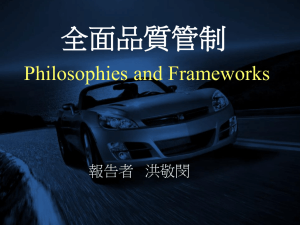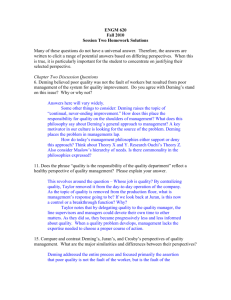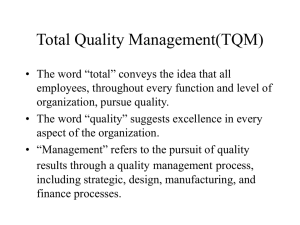PRODUCTIONS/OPERATIONS MANAGEMENT
advertisement
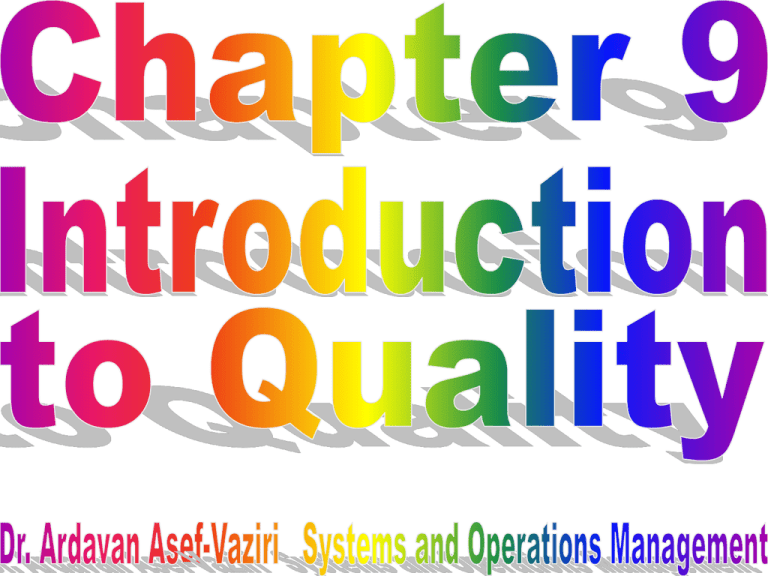
Quality Management Quality is the ability of a product or service to consistently meet or exceed customer expectations. Dimensions of Quality • Performance - main characteristics of the product/service • Special features - extra characteristics • Conformance - how well product/service match to customer’s expectations • Aesthetics - appearance, feel, smell, taste • Durability - useful life of the product/service • Reliability - consistency of performance • Service after sale - handling of customer complaints or checking on customer satisfaction Examples : Dimensions of Quality Dimension (Product) Automobile 1. Performance Everything works, Ride, handling, grade of materials used 2. Aesthetics (Service) Auto Repair All work done, at agreed price Friendliness, courtesy, Competency, quickness Interior design, soft touch Clean work/waiting area 3. Special features Cellular phone, CD Convenience player High tech Location, call when ready Computer diagnostics 4. Safety Separate waiting area Antilock brakes, airbags Examples : Dimensions of Quality Dimension (Product) Automobile (Service) Auto Repair 5. Reliability Infrequency of breakdowns Work done correctly, ready when promised 6. Durability Useful life in miles, resistance to rust & corrosion Work holds up over time 7. Perceived quality Top-rated car Award-winning service department 8. Service after Handling of complaints and/or Handling of complaints sale requests for information The Consequences of Poor Quality • Loss of business • Liability • Low productivity Costs of Quality • Failure Costs – Internal – External • Appraisal Cost • Prevention Costs Costs of Quality • Failure Costs - costs incurred by defective parts/products or faulty services. • Internal Failure Costs Costs incurred to fix problems that are detected before the product/service is delivered to the customer. Examples; Material, labor and capacity loss, scheduling difficulties for re-work • External Failure Costs All costs incurred to fix problems that are detected after the product/service is delivered to the customer. Examples; Returned products, loss of goodwill, liability, claims Costs of Quality • Appraisal Costs Cost of inspecting material, parts, and products to to ensure their conformance with quality standards Example; labor and material cost of inspecting equipment, cost of interruption in production • Prevention Costs Cost of preventing defects from occurring Example; Total Quality Management costs Key Contributors to Quality Management Contributor Known for Quality Deming 14 points; special & common causes of variation Juran Quality is fitness for use; quality trilogy Crosby Quality is free; zero defects Ishikawa Cause-and effect diagrams; quality circles Deming A professor of statistics in 1940s. Went to Japan after WWII to assist Japanese in improving quality and productivity. Japanese established Deming prize for quality. Deming was unknown in his home country until 80s He developed a famous list of 14 points he believed were key for quality in organizations. His message was; System is the cause for inefficiency and poor quality not employees. It is management’s responsibility to improve the system. The essence of his 14 points are; Constancy of purpose, continuous improvement, profound knowledge. Deming : Profound Knowledge Profound knowledge is; appreciation for the system, theory of variation, theory of knowledge, and psychology. Appreciation for the system;.Every one in the organization working to achieve overall optimization. Management most eliminate internal competition. Theory of Variation; Variation reduction is an important key to quality. There are two types of variations; random and correctable. We should concentrate on the later. Theory of Knowledge; Knowledge comes from theory. Learning can not occur in an organization without a theory of knowledge. Psychology; Workers want to create and learn. Management’s greatest challenge is to motivate workers to contribute their common effort to achieve a common goal. Deming’s 14 Points 1.Constancy of purpose toward improvement. 2.We can no longer live with defects and delays. 3.Forget mass inspection, rely on statistical process control (SPC). 4. Eliminate unqualified suppliers. Not just price, but Price + quality. 5.Work continually on the system, identify problems, resolve them. 6.Institute modern methods of training on jobs. 7.Responsibility of foremen is not productivity but quality, which in turn improves productivity. Management takes immediate action on foremen requests regarding improvement in elements of the system. 8.Drive out fear, so that every one may work effectively for the company. 9.Break down barriers between departments. Motivate team work. 10.Do not ask for more productivity, without providing methods. 11.Eliminate work standards that prescribe numerical quotas. 12.Break down barriers between hourly and permanent workers. 13.Institute a vigorous program for education and retraining. 14.Top management will push every day on the above 13 points. Juran He made his first trip to Japan after publication of his Quality Control Handbook in 1951. His method is close to that of Deming, but with two main differences. 1) Management of quality is not very difficult. 2) He places less emphasize on SPC. His initiatives; Quality begins by knowing what customer wants. Quality is fitness-for use. Almost 80% of quality defects can be controlled by commitment of management to continuos improvement. Quality management is 1) quality planning, 2) quality control, and 3) quality improvement. He showed high cost of low quality, and potentials of cost reduction through quality improvement. Quality Awards Baldrige Award Deming Prize Malcolm Baldrige National Quality Award 1 Leadership (110 points) 2 Strategic Planning (80 points) 3 Customer and Market Focus (80 points) 4 Information and Analysis (80 points) 5. Human Resource Development and Management (100 Points) 6 Process Management (100 points) 7 Business Results (450 points) TOTAL = 1000 Baldrige Award Characteristics of Baldrige Award Winners • The companies formulated a vision of what they thought quality was and how they would achieve it. • Senior management was actively involved. • Companies carefully planned and organized their quality effort to be sure it would be effectively initiated. • They vigorously controlled the overall process. The Deming Prize • Honoring W. Edwards Deming • Japan’s highly coveted award • Main focus on statistical quality control Deming Prize International Organization for Standardization • ISO Series • Set of international standards on quality management and Quality assurance that are critical to international business • Requires firms to document every thing they do that affects the quality of goods and services. • Document every step (incoming raw materials, product design, in-process monitoring and so forth) to be able to identify those areas that are causing quality problems and correct them. ISO 9000 Registration Process • When an organization feels that its quality system is good enough, it may ask for assessment. • The audit begins with a review of the company's quality manual. The audit team checks to see that the documented quality system meets the requirement of ISO 9000 and that the organization is practicing what is documented. • When the registrar is satisfied with the recommendation of the audit team, it issues a registration document to the company. ISO 9000 Series ISO 9000 ISO 9001 ISO 9002 ISO 9003 ISO 9004 Helps companies determine which standard of ISO 9001, 9002, and 9003 applies Outlines guidelines for companies that engaged in design, development, production, installation, and servicing of products or service Similar to 9001, but excludes companies engaged in design and development Covers companies engaged in final inspection and testing The guidelines for applying the elements of the quality management system Reading The cost of quality, 401-402 Quality gurus 402-406
